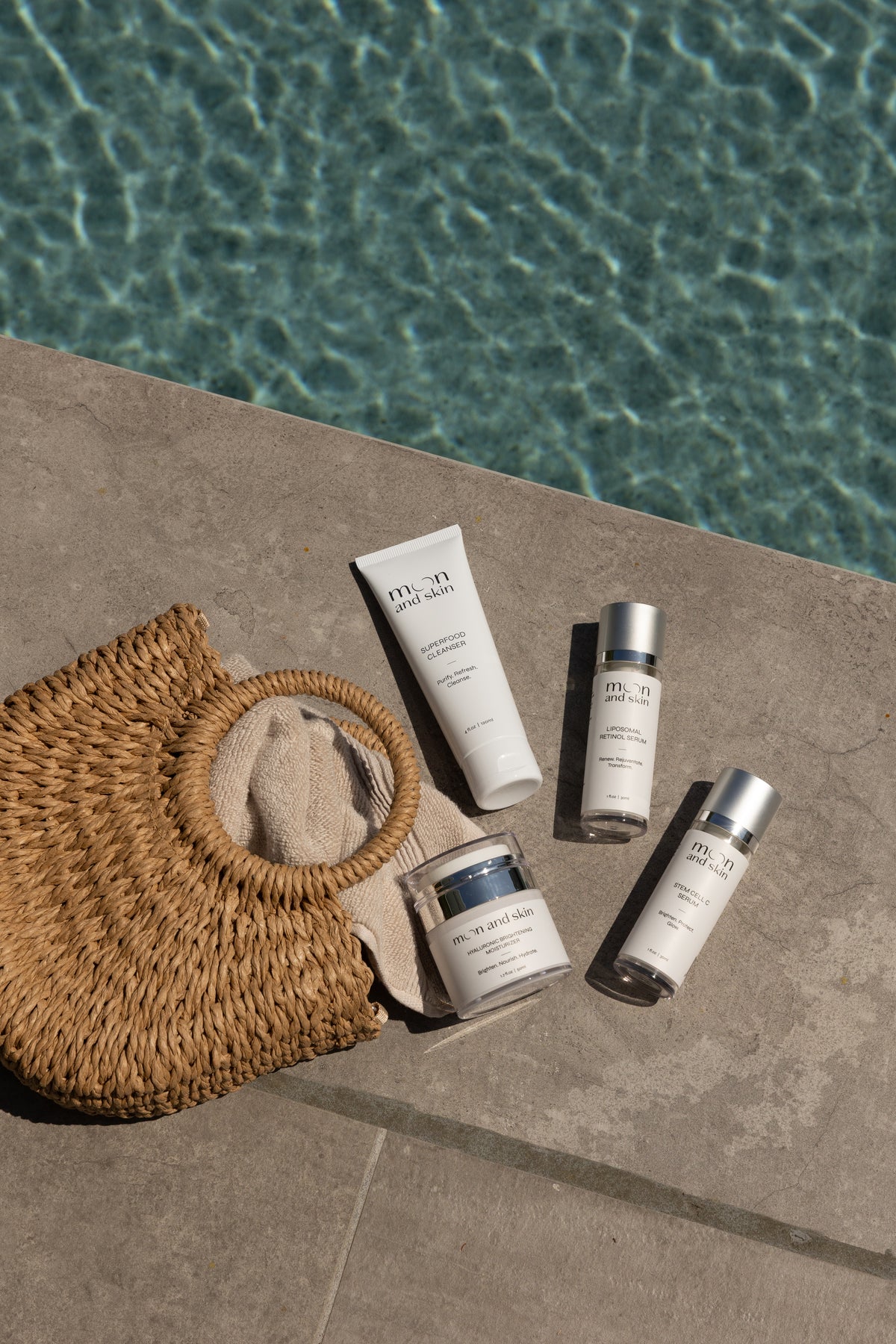Table of Contents
Introduction
Have you ever noticed how many skincare products proudly feature vitamin E on their ingredient list? This often-overlooked vitamin plays a vital role in maintaining skin health, but a common question arises: is vitamin E hydrating? Our skin, much like our lives, undergoes various phases and changes, necessitating ingredients that not only nourish but also hydrate. At Moon and Skin, we understand that navigating skincare ingredients can be overwhelming, and we’re here to illuminate the benefits of vitamin E and how it can be a crucial part of your skincare routine.
In this post, we’ll explore the hydrating properties of vitamin E, how it interacts with other skincare ingredients, and the best ways to incorporate it into your routine. We’ll also highlight some of our key products that harness the power of vitamin E, offering you a path to healthier, more hydrated skin.
Understanding Vitamin E
What is Vitamin E?
Vitamin E refers to a family of fat-soluble compounds known as tocopherols and tocotrienols. The most common form found in skincare products is alpha-tocopherol, which is recognized for its potent antioxidant properties. Antioxidants work to neutralize free radicals—unstable molecules that can cause damage to skin cells and accelerate aging. By combating oxidative stress, vitamin E plays a significant role in maintaining skin health.
How Does Vitamin E Hydrate the Skin?
Vitamin E is often celebrated for its ability to provide hydration, but what does that actually mean? Let’s break it down:
- Humectant Properties: Vitamin E functions as a humectant, meaning it attracts moisture to the skin. By pulling water from the air and deeper layers of the skin, it helps to keep your skin hydrated.
- Emollient Effects: This vitamin also acts as an emollient, which means it forms a barrier on the skin’s surface to lock in moisture. This dual action of attracting and retaining hydration makes vitamin E a powerful ally for dry or dehydrated skin.
- Supporting Skin Barrier: A well-functioning skin barrier is crucial for maintaining hydration levels. Vitamin E helps strengthen this barrier, ensuring that moisture stays locked in while environmental aggressors are kept at bay.
Who Can Benefit from Vitamin E?
Vitamin E is suitable for various skin types, particularly:
- Dry Skin: If your skin feels tight or flaky, incorporating vitamin E can help restore moisture levels.
- Sensitive Skin: Its anti-inflammatory properties can soothe irritation, making it a great option for those with sensitive skin.
- Aging Skin: With its antioxidant benefits, vitamin E can help reduce the appearance of fine lines and promote a youthful glow.
However, it’s essential to note that while most people can benefit from vitamin E, those with very oily or acne-prone skin should approach it with caution, as it can occasionally exacerbate breakouts.
The Science Behind Vitamin E’s Hydration
Numerous studies support the hydrating benefits of vitamin E. For example, research has shown that topical application of vitamin E can significantly enhance skin hydration levels and improve barrier function. In a study published in the International Journal of Pharmaceutics, it was found that vitamin E significantly increased the water-binding capacity of the skin, leading to improved hydration.
How Vitamin E Works with Other Ingredients
To maximize its benefits, vitamin E is often combined with other ingredients in skincare formulations. One of the most powerful combinations is vitamin E with vitamin C. This duo not only boosts hydration but also enhances the efficacy of both vitamins. Vitamin C helps regenerate vitamin E after it has neutralized free radicals, providing enhanced protection for the skin.
Incorporating Vitamin E into Your Skincare Routine
Best Ways to Use Vitamin E
As you embark on your journey to achieve hydrated, healthy skin, here are some effective ways to incorporate vitamin E into your routine:
- Serums: Look for serums that contain vitamin E alongside other hydrating agents. Our Stem Cell C Serum includes vitamin E, providing a brightening effect while deeply hydrating your skin.
- Moisturizers: A good moisturizer can work wonders. Our Hyaluronic Brightening Moisturizer is formulated with hyaluronic acid and vitamin E to boost hydration levels and brighten your complexion.
- Facial Oils: Consider using a facial oil that contains vitamin E for an added moisture boost. Applying it at night can help your skin recover while you sleep.
- Sunscreens: Sunscreens that include vitamin E can enhance protection against UV damage while simultaneously providing hydration.
How to Layer Products with Vitamin E
When incorporating vitamin E into your routine, layering is essential. Here’s a simple step-by-step guide:
- Cleanser: Start with a gentle cleanser like our Superfood Cleanser to remove impurities.
- Serum: Apply a vitamin E serum or one that contains vitamin E after cleansing.
- Moisturizer: Follow with a hydrating moisturizer.
- Sunscreen (AM routine): Finish with a broad-spectrum sunscreen to protect your skin from UV damage.
The Benefits of Our Moon and Skin Products with Vitamin E
At Moon and Skin, we prioritize clean and thoughtful formulations that cater to every phase of life. Our core products harness the power of vitamin E while ensuring they are safe for all skin types.
- Stem Cell C Serum: Enriched with stable vitamin C and vitamin E, this serum brightens and hydrates while protecting your skin from environmental stressors.
- Hyaluronic Brightening Moisturizer: This lightweight moisturizer combines hyaluronic acid and vitamin E to provide intense hydration and improve skin texture.
- Superfood Cleanser: Our gentle cleanser nourishes while preparing your skin for subsequent hydration steps.
- Liposomal Retinol Serum: While primarily focused on anti-aging, this serum is designed to minimize irritation and can be paired with vitamin E for enhanced hydration.
Try Before You Buy
We understand that choosing the right products can be daunting. That’s why we offer a Try Before You Buy collection. Experience our products without commitment and find your perfect match!
Conclusion
In conclusion, vitamin E is indeed hydrating and serves as a multifunctional ingredient that combats dryness and enhances overall skin health. By understanding its properties and how to incorporate it into your skincare routine, you can harness its benefits to achieve hydrated, vibrant skin.
We invite you to explore our Bundle & Save collection, where you can combine our best-selling products and build a comprehensive skincare routine tailored to your needs. Together, let’s celebrate your skin through all its phases and transitions.
FAQ
Is vitamin E safe for all skin types?
While vitamin E is generally safe for most skin types, those with very oily or acne-prone skin should use it cautiously, as it may exacerbate breakouts.
Can I use vitamin E oil directly on my skin?
Yes, you can apply vitamin E oil directly to your skin, but it’s advisable to perform a patch test first to ensure you do not have a sensitivity or allergic reaction.
How often should I use vitamin E in my skincare routine?
You can use vitamin E daily, especially in serums and moisturizers. However, adjust based on your skin's response and needs.
Can vitamin E help with scars?
Vitamin E may help improve the appearance of scars by keeping the skin moisturized and supporting the healing process, though results can vary.
What other ingredients should I pair with vitamin E?
Pairing vitamin E with vitamin C can enhance its antioxidant effects and provide additional hydration, making this combination a powerful duo for your skincare routine.







